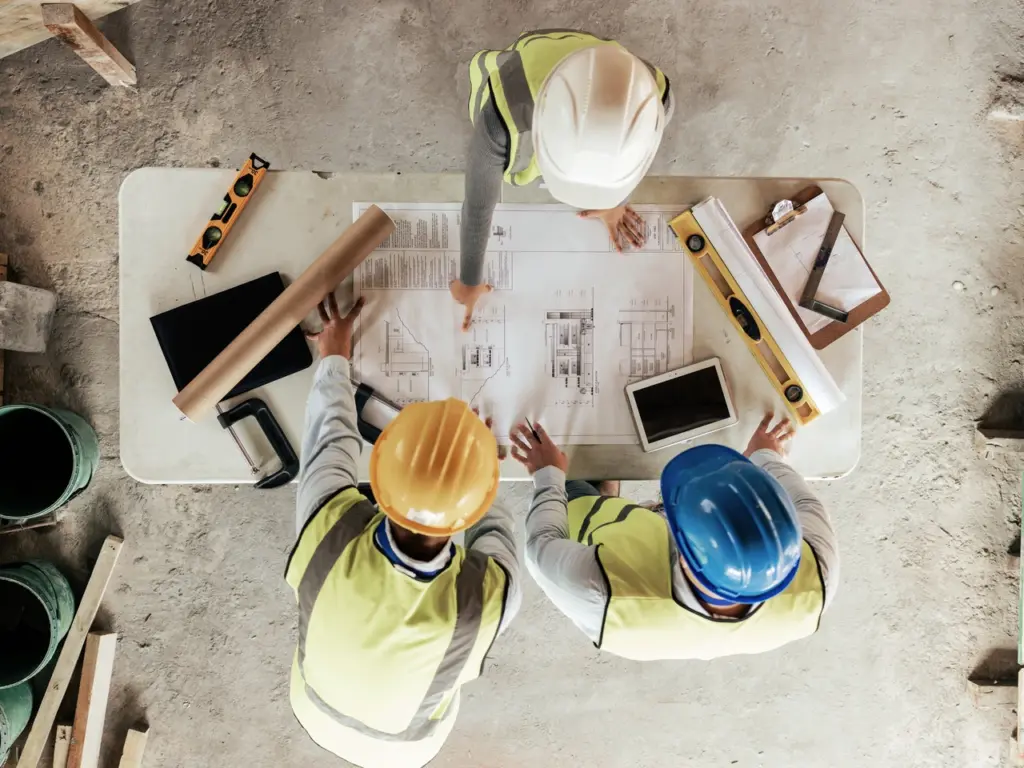How do you determine the best project delivery method for your construction project? Choosing the right delivery method, whether it’s design-bid-build or design-build, plays a key role in the success of your construction project.
These two commonly used methods offer distinct advantages and disadvantages that can influence your project’s efficiency, cost, timeline, design and construction.
In this article, we’ll break down the key differences between design-bid-build and design-build, helping project owners make informed decisions. Understanding these delivery methods can make or break your project, ensuring smooth implementation and successful completion.
What is Design-Bid-Build?
The design-bid-build method is a widely used project delivery method in the construction industry, following a structured process that involves design, bid, and build phases. This method allows project owners to manage the design and construction phases separately. Here’s how it works:
- Design Phase: The project owner hires an architect, designer, or design team to complete the design process, creating the design documents needed for the construction project.
- Bidding Process: Once the design is finished, the bidding process begins. Contractors bid on the project, and the most suitable bid is selected to carry out the construction work.
- Build Phase: After a contractor is selected, the construction phase starts, adhering to the completed design documents and plans.
This design-bid-build method gives project owners greater control over design decisions. It’s typically used for infrastructure projects and traditional project delivery where the design and construction phases are clearly separated. This method ensures that each phase is completed before moving to the next, minimizing potential change orders.
What is Design-Build?
Design-build is a project delivery method in which the project owner enters into a one contract with single contractor that handles both the design and construction phases. Unlike the traditional design-bid-build approach, where the design and construction are managed separately, design-build integrates these phases, resulting in a more cohesive and efficient construction process.
Key aspects of design-build include:
- Single point of responsibility: The contractor is responsible for both design and construction, simplifying communication and accountability for the project owner.
- Faster project delivery: With design-build, the design and construction phases can overlap, allowing construction to begin before the design is fully completed, reducing overall project time.
- Cost control: This method often helps prevent cost overruns, as the design and construction teams work closely to ensure the project stays within the budget from the outset.
Choosing the design-build method can streamline your construction project, but it’s important to weigh its benefits and limitations based on the specific needs of your project.
Design Bid Build vs Design Build Construction Project Delivery Method: Advantages and Disadvantages

Understanding the pros and cons of the design-bid-build method is crucial for project owners when deciding on a project delivery method for their construction projects. Here’s a breakdown of the advantages and disadvantages:
Pros of Design-Bid-Build
The design-bid-build project delivery method offers several advantages, making it a popular choice in the construction industry. Below are the key benefits:
- Clear Separation of Phases: The design-bid-build method distinctly separates the design and construction phases, ensuring clarity and reducing overlap.
- Competitive Bidding Process: The structured bidding process enables multiple contractors to bid on the project, usually resulting in better pricing for the project owner.
- Owner Control Over Design: The project owner has greater control over all design decisions, as the design is finalized before the contractor is selected.
- Fewer Change Orders: With the design completed prior to construction, there is a reduced risk of change orders, helping to minimize cost overruns.
- Familiar in the Construction Industry: This method is well-known and widely practiced in the construction industry, ensuring a predictable and reliable workflow.
- Suited for Public Projects: The transparency of the bidding process makes it ideal for infrastructure projects and government contracts, promoting fairness and accountability.
- Detailed Design Documentation: A comprehensive set of design documents is produced, providing clear guidelines for contractors during the construction phase.
- Independent Oversight: The project owner maintains separate contracts with the design team and contractor, allowing for independent oversight and quality control.
- Less Contractor Influence on Design: Since contractors are engaged after the design phase, their influence on design decisions is limited, preserving the owner’s vision.
- Predictable Budgeting: Finalizing the design and receiving bids based on complete documents helps the project owner manage budgets effectively and reduces surprises during the construction process.
Cons of Design-Bid-Build
While the DBB method offers a structured approach to project delivery, it also comes with several disadvantages that project owners should consider:
- Longer Project Delivery Time: The design-bid-build method typically results in a longer overall project delivery time, as the design phase must be completed before the construction project begins.
- Potential for Miscommunication: The separation between the design team and contractor can lead to miscommunication, resulting in discrepancies that may affect the quality of the construction project.
- Limited Collaboration: Early collaboration is often lacking in the design-bid-build process, which can prevent the incorporation of valuable feedback from contractors during the design phase.
- Higher Costs from Change Orders: If modifications arise during the construction phase, it can lead to numerous change orders, causing cost overruns and delays in project delivery.
- Reduced Flexibility: Once the design is finalized, making adjustments becomes challenging and costly, limiting flexibility throughout the construction project.
- Bidding Challenges: The bidding process can be lengthy, and focusing on the lowest bid may result in hiring contractors who lack the necessary experience or quality.
- Risk of Low Bids: Contractors might submit low bids to secure the project, which can lead to issues during construction if the initial bid does not cover actual costs.
- Complex Management of Contracts: The project owner must manage separate contracts with the design team and the contractor, complicating project delivery and oversight.
- Fragmented Accountability: In the event of project issues, determining accountability can be tough, as the responsibilities of the design team and contractor are not integrated.
- Limited Innovation Opportunities: The traditional structure of the design-bid-build delivery method may suppress innovation, as contractors are not involved in the design phase to propose new solutions.
Pros of Design-Build
The DB project delivery method provides multiple benefits that can greatly improve the success of your construction project. By integrating design and construction services under a single contract, design-build offers significant benefits for project management. Below are the advantages of design-build:
- Single Point of Responsibility: In design-build, the construction manager, builder, and design team work under one contract, making project management simpler and more efficient.
- Faster Project Delivery: The design-build delivery allows construction to begin while the design phase is still ongoing, speeding up the entire construction process.
- Cost Efficiency: The integration of construction services and design helps reduce the likelihood of cost overruns, as both phases are managed together from the outset.
- Streamlined Communication: The project owner interacts with a single entity, improving communication and reducing the risk of misunderstandings between the design and construction teams.
- Fewer Change Orders: By having the construction manager and builder involved early, potential design flaws are addressed before construction begins, resulting in fewer costly change orders.
- Enhanced Collaboration: The close partnership between the design team and construction manager ensures a seamless transition between design and construction, leading to better project outcomes.
- Higher Quality: With the builder and designer working together from the start, the overall quality of the project is often improved, as the teams align on goals and execution strategies.
- Improved Risk Management: The construction manager takes on more responsibility, managing both the design and construction services, reducing the project owner’s exposure to risks.
- Increased Innovation: Design-build encourages creative solutions, as the construction management team collaborates closely with designers to deliver innovative and cost-effective results.
- Efficient Project Management: The design-build delivery model simplifies project management by integrating construction management and design processes, resulting in a more streamlined and organized project workflow.
Cons of Design-Build
While the design-build process has its advantages, it also presents challenges that project owners should consider before choosing this project delivery approach. Here are the key cons of design-build:
- Less Control Over Design: The project owner has limited control over the design aspect since the design-build approach integrates both design and construction under one contract, unlike the traditional method that separates design and bidding.
- Higher Initial Costs: The design-build process may lead to higher upfront costs due to early collaboration between the contractor and design team, making the design-bid-build method potentially more cost-effective initially.
- No Competitive Bidding: The design-build approach bypasses traditional competitive bidding, offering fewer opportunities to explore multiple bids for cost savings.
- Potential Conflicts of Interest: The way the contract is written may prioritize construction efficiency over the project’s design quality, leading to compromises on design elements.
- Not Ideal for Complex Projects: Design-build is commonly used for projects that have high-efficiency demands; however, complex projects may benefit more from the traditional delivery method or integrated project delivery.
- Limited Financial Transparency: With integrated design and construction, project owners may struggle to track expenditures clearly, making cost transparency less evident than in a design-bid-build project.
- Risk of Compromised Quality: The focus on speed and cost reduction in design-build can compromise quality, with potential shortcuts taken during actual construction.
- Reduced Opportunity for Design Review: Merging design and construction phases results in fewer opportunities for the project owner to review design proposals, limiting control over the final outcome.
- Challenging for New Project Owners: Inexperienced project owners may find design-build harder to manage, as it requires solid knowledge of both the design-build process and lean construction practices.
- Dependence on Contractor’s Expertise: The success of design-build relies heavily on the contractor’s ability to provide effective design and execution; lack of expertise can lead to delays or cost overruns.
Design-Build vs Design-Bid-Build Process: Key Differences

Understanding the key differences between design-bid-build and design-build can help determine the right project delivery method for your construction project. Both methods offer distinct approaches to managing and executing the project, but the difference in how they are structured can make one a better fit for your project.
Project Structure and Phases
The two project delivery methods have fundamentally different structures. In design-bid-build, the project owner has separate contracts with the designer and the contractor.
This traditional project delivery method allows the owner more control over the design, but it may extend timelines.
On the other hand, progressive design-build integrates both design and construction phases into a single contract, meaning construction can begin earlier, streamlining the project delivery and accelerating the overall process.
Owner Involvement
In design-bid-build, the owner during the design phase has significant input, providing feedback before the bidding process. However, design-build shifts more responsibility to the design-build team.
Contractor-led projects usually don’t rely on the same level of owner management, but this can lessen complications and disputes once construction starts.
Choosing the right level of involvement is key to deciding which method is right for your project.
Risk Management and Accountability
Design-build reduces risk by offering a single point of responsibility, simplifying project management and execution.
By having one contract with the designer and contractor, the owner benefits from fewer disputes and better coordination.
In contrast, design-bid-build divides accountability between different parties, which can lead to conflicts or delays, especially depending on who the contract is awarded to.
Cost and Timeline
Design-bid-build is generally used on projects where competitive bidding can lower costs. However, its sequential nature can extend timelines.
In design-build, starting construction earlier and streamlining the project, can reduce the overall project duration, though initial costs may be higher as competitive bidding is eliminated.
Flexibility and Project Fit
Design-bid-build is ideal for projects that have a high need for design flexibility, allowing adjustments before construction.
However, mid-project changes can result in cost overruns. Design-build, with its integrated approach, is less flexible once construction starts, but it’s better suited for projects that need a faster, streamlined delivery system.
Choosing the right project delivery approach should fit the specific requirements of the project at hand.
Expertise and Collaboration
In design-bid-build, the owner often hires separate teams, leveraging the design and construction expertise of each group independently.
In design-build, collaboration between the design and construction teams is integrated from the start, providing a comprehensive set of construction services.
This collaboration ensures that design and construction are aligned, reducing the chances of miscommunication or delays.
When Should You Use the Design-Bid-Build Delivery Method?

There are specific scenarios where the design-bid-build delivery method is particularly advantageous:
- Complex Projects: For projects that require extensive design documentation and detailed specifications, design-bid-build can ensure that the project owner retains control over the design elements and can make informed decisions based on competitive bids.
- Owner Expertise: If the project owner has considerable experience in managing construction projects, they may choose the design-bid-build approach to maintain control over the design and contractor selection processes.
- Regulatory Requirements: In some cases, local regulations may dictate the use of a specific delivery method, making design-bid-build the only viable option.
- When Should You Use the Design-Build Delivery Method?

Conversely, the design-build method is best suited for specific circumstances:
- Tight Timelines: Projects that need to be completed quickly benefit from the design-build method due to its capacity to overlap design and construction phases.
- High Complexity: When a project involves significant design and construction challenges, having a single point of responsibility can streamline decision-making and enhance problem-solving capabilities.
- Desire for Collaboration: If the project owner values collaboration and open communication throughout the design and construction processes, design-build can enable a more cooperative environment.
How to Choose the Right Project Delivery Method for Your Construction Project?
Selecting the right project delivery method requires careful consideration of various factors:
Project Complexity and Size
Evaluate the complexity of the project and the resources available. Larger, more complex projects may benefit from the clear structure of design-bid-build, while simpler projects might thrive with the efficiency of design-build.
Timeline and Budget
Consider the project timeline and budget limitations. Design-build is usually more suited for projects requiring quick completion, whereas design-bid-build may provide better price competition.
Owner Experience and Preferences
Assess the project owner’s experience in construction management and their preference for involvement in the design process. This can greatly influence which delivery method aligns best with their goals.
Final Thoughts
Choosing between the design-bid-build and design-build project delivery methods comes down to the specific needs of your construction project.
If you wish to maintain control over the design and allow competitive bidding to manage costs, the design-bid-build method can provide the structure you need.
On the other hand, if you’re looking for a faster, more collaborative approach where a single entity can provide both design and construction services, the design-build method might better fit the project. Ultimately, selecting the right method ensures smoother execution and successful project completion.
Frequently Asked Questions
What is the Design-Bid-Build (DBB) project delivery method?
The Design-Bid-Build (DBB) method is a traditional approach where separate entities provide design and construction services. Here’s how DBB works:
Separate Contracts: The owner hires a designer to provide design services and then contracts a separate firm to provide construction services.
Competitive Bidding: Once the design is complete, contractors bid on the project, and the owner picks the most suitable one to provide construction services.
Clear Accountability: Each party is responsible for its own phase, allowing for better clarity in who provides the design and who provides the construction services.
DBB is ideal for projects where separating design and construction services ensures clear roles and accountability.
What is the Design-Build (DB) project delivery method?
The Design-Build (DB) method integrates both design and construction services under one contract for streamlined project delivery. Here’s how DB works:
Single Contract: A single contractor is contracted to provide both design and construction services, simplifying the process.
Faster Timelines: With design and construction services provided simultaneously, project timelines can be significantly reduced.
Collaborative Process: Since both services are provided by the same team, there’s greater collaboration and efficiency throughout the project.
Design-Build offers a streamlined approach where both design and construction services are provided by a single entity, enhancing coordination and speed.
What are the main advantages of the Design-Bid-Build method?
In the Design-Bid-Build method, design and construction services are provided separately, offering distinct advantages for project management. Here’s why DBB might be right for you:
Clear Separation of Roles: Design and construction services are provided by separate firms, making it easier to hold each accountable.
Competitive Bidding: Construction services are awarded competitive bidding, which may result in cost savings.
Owner Control: The owner has greater control over the design before construction services are provided, ensuring the desired outcome is met.
The DBB method is beneficial for projects where you want separate providers for design and construction services, with more control over each phase.
What are the main advantages of the Design-Build method?
Design-Build offers a consolidated approach where one firm provides both design and construction services, which can be highly advantageous. Here’s why DB might work for your project:
Faster Completion: Design and construction services are provided concurrently, which shortens the overall project timeline.
Single Point of Responsibility: With one entity providing both services, communication is streamlined, and issues can be addressed quickly.
Cost Efficiency: Early collaboration between the design and construction teams can lead to cost-effective solutions since both services are provided by the same company.
Design-Build is ideal for projects where having one provider for both design and construction services can lead to quicker and more efficient delivery.
How do you decide between Design-Bid-Build and Design-Build for your project?
Choosing the right delivery method depends on how you prefer design and construction services to be provided. Here’s how to decide:
Project Complexity: If your project requires high owner involvement in design, DBB might be better since design and construction services are provided separately. DB is better suited for less complex projects that benefit from faster delivery.
Timeline Constraints: Design-Build allows for design and construction services to be provided concurrently, which speeds up completion. DBB, with its separate phases, may result in more predictable scheduling.
Budget and Risk: DBB offers more price control since construction services are bid out. DB reduces risks by having one entity provide both services, streamlining decision-making.
Deciding between DBB and DB involves evaluating your priorities in how design and construction services are provided, based on complexity, timeline, and cost.

